|
In
the early summer of 1985 one of New York's avenues was cut off.
The crane blocking the street prized a wooden crate into the Heller
Gallery. Bertil Vallien could not have wished for better publicity
on the presentation of his new boat sculpture.
Bertil
maintains that he was slow to mature as an artist due to his double
role of designer and sculptor. By the end of the 70s he decided
to focus more on the artistic side. He had come to the point where
he was forced to come to grips with his approach to life, to move
forward and start something new. The breaking point coincided with
a number of significant personal experiences. The artist was at
a crossroads. The new departure gave rise to a series of ceramic
boats in 1979 that would point him in the right direction.
The choice
of boat as a sculptural theme was an apt embodiment of Vallien's
many-sided artistry. The boat is a vehicle that carries a cargo,
either material or immaterial. Gunnar Lindqvist describes the importance
of the boat for Bertil Vallien:
"...He must constantly be on the move both mentally and
imaginatively as well as in his work and geographically. The 80s
for Bertil Vallien were a decade of free flight."
Bertil
began the decade by refining the form he had begun in the 70s. During
1982-83 he worked with small sand-moulded cubes with rough surfaces
- houses of glass with a stairway. One side of the cube is semi-transparent
enabling one to see inside. In the centre of the sculpture is a
tiny object. Though small, these cubes have an alluring power. When
Bertil exhibited them at the Old Town Gallery the critics were disoriented
but impressed.
"Glass
eats light", is an expression coined by BV in the early 80s,
and which became his motto. Normally glass reflects the light, but
Bertil meant that light is trapped in the sculpture as an inner
glow. GL describes it as "the anguished Northern light",where
the angst is channelled into a hopeful quest.
Alongside
the cubes two of Bertil's most powerful portrayals came into being.
Sven Delblanc, 1982 (Swedish author) and Jerzy Kosinski, 1983 (Polish
author). The two-part sculptures are 40 cm high. In the former,
the base is composed of a stairway resembling the author's goatee
beard; the facial expression is meditative and two clear glass rods
form the eyes, which are lowered. The face of Kosinski stares threateningly
ahead. (This portrait was the outcome of a personal experience,
when for some unknown reason, Bertil was pursued by Kosinski for
a time.)
- In
the 70s I read some books by Kosinski, tells Bertil. They are fantastic
and terrifying thrillers where people get killed by advanced bullying.
Then I made a sand-casted portrait of Jerzy Kosinski. The portrait
was sold at an exhibition in New York in 1983. One day the owner
of Heller Gallery, Mr. Douglas Heller, called me and said that Kosinski´s
lawyer had bought the sculpture. "That is brilliant!"
I said. Kosinski was around that time involved in a quite nasty
story. He was accused for murder of his wife, a loaded american
woman. It strenghten my picture of him; a wasted man. Anyway, after
awhile I got a pile books sent to my home. Without any sort of greetings.
Then, I recieved strange telephonecalls. I thought I was choosen
as one of his victims.It was a strange feeling to be contacted by
such fantastic author. He never told me what he really wanted but
he wondered why his eyes on my portrait was so ugly. One day Kosinski
was at NK in Stockholm for signing books. I payed a visit there
with Lasse Åberg ( artist and filmmaker). Finally I step forward
and told him who I was. After awhile he said: "I do not know
you." and Kosinski left the room.
The years
82-83 represent a tremendous liberation of Vallien's artistic powers.
He began with the first mouldings of the boat form that would soon
bring him world fame - he had already done some ceramic boat sculptures
in the 60s. The first sand-casted glasswhich came out in 1977, had
a smooth finish. In 1983 the first boats were exhibited at the Heller
Gallery in New York and in Melbourne, Australia, and were immediately
noted by the international body of critics. In the reputable Corning
Museum's New Glass Review, 6, 1984, Dr Helmuth Ricke of the Dusseldorf
Museum of Art wrote the following:
"
Boats are symbols with a definite meaning. They stand for the journey
from yesterday to tomorrow; they are laden with the relics of the
past which might have no meaning for the future. In ancient oriental
cultures, boats are often vehicles for the 'last journey'. The Swede,
Bertil Vallien, challenges our comprehension. He also stirs thoughts
of the past - weren't the Scandinavian Viking princes buried in
ships laden with objects for the after-life? Doesn't the spade-cut
texture of the outer skin of Vallien's boat remind one of an archaeological
find which has just been excavated - a coarse and insignificant-looking
container for the valuable objects housed in its interior? Perhaps
the historian and archaeologist in me lead my ideas astray. Others
have different opinions. They react more to the lightness, the playful
element which exhibits a completely different facet of the work.
Yet it is also a game with old and meaningful symbols: rings, chains,
sceptre-like rods, a stairway, a wheel - ambivalent objects that
appear to be interchangeable on a whim. In this manner, Bertil Vallien's
work combines a number of relationships. One level of meaning overshadows
another; in the end it is unfathomable and thus free of speculation
or of penetrating pseudo-implication, which is still a characteristic
of some of the more pretentious works in glass. I am interested
in the tracks that human beings leave behind when they cease to
exist. Bertil Valliens boat seems to be connected to this theme."
I will try to dissect Ricke's interesting, though rather abstract
analysis of Bertil's boats. Central to this analysis is (the phrase)
"one level of meaning overshadows another".
What symbols does Vallien use in his boats? Do the boats always
carry a death theme? What is he expressing with his boats?
The last
question is both the easiest and the most difficult to answer. He
has said: "I chose the boat because it is such a beautiful
shape - it contains both mystery and symbolism. The boat signifies
a voyage, the Voyage of Life. People see these vessels as a protection
from the unknown and the dark"
It is harder to explain the symbols he fills them with. Is he a
conscious mystic with a clear plan for what the boats should contain,
ready for us onlookers to accept? Bertil again:
"I
choose the words but do not consciously choose their arrangement;
the sentences which materialise have certainly no counterpart in
my mind, they occur quite by chance"
Although
he is assuredly a conscious artist who can intellectually explain
his art, his guiding stars are imagination (fantasy) and spontaneity.
The subconscious plays a central role in the boat sculptures. The
symbolic meaning to be found there is subjective, varying from person
to person, and it is always ambivalent. It is easiest to see the
boats as carriers of something from the past, dead material. Boats
can also be seen as a journey into the subconscious, a world inhabited
by life and death in symbiosis. Whether it is his subconscious or
our own, no one can say. Bertil Vallien wishes to awaken our imagination
and our subconscious. A symbol often found in his boats is the rod.
It implies permanency, a link with time and the basis of consciousness.
The rod is the boat's heart, a memory bank
The Australian
art veteran, Jenny Zimmer is of the opinion that the symbols Bertil
has introduced belong to the universal, or 'collective unconscious'.
According to the psychiatrist Carl Jung, archetypes replace the
intuitive subconscious. The archetype is an anarchist that both
aids and confuses people's interpretation of the subconscious. They
are unhindered by cultural, social or religious barriers and speak
a common language. For Bertil chance plays a large part at the inception
of a creation. It is not enough to load the work with symbols; a
metaphysical element must be captured in the moment. A work of art
should encapsulate an inner light, a soul. Jenny Zimmer refers to
Vallien's art as Psychological Expressionism.
"BV's
sand-casted glass, with its mysterious shrouded depths and luminous
opacity, focuses on the inner form of the translucent solid. The
sand-casts are like ancient moonstones or weathered crystal-quartz
whose surface tells a story, but within which secrets are hidden
only to glow seductively where some cunning detail interrupts the
outer skin.
It may seem presumptuous to make this broad analogy but, to me,
these glass sculptures embody the spiritual-artistic ethos of Scandinavia
as it suggests itself to a non-European through its visual arts
and literature. In these extraordinarily sensitive glass statements
- the products of chance as much as design - Vallien demonstrates
once again, the Scandinavian preoccupation with the Jungian psychic-world
of archetypes, of hazardous journeys of self-individuation and of
the dualities of the natural and spiritual universes. The claustrophobia
generated by the playwright Ibsen, the neuroses explored by the
painter Munch and the vagaries and truths of human nature so much
the province of the film-maker Ingmar Bergman, are also the terrain
of Bertil Vallien."
1985
was the year of Vallien's international breakthrough. Winning a
second place in the Zweiter Coburg Prize for modern glass sculpture
in Europe, established his reputation as a major glass artist. The
Zweiter Coburg prize, considered to be the most prestigious in the
world, is awarded every 7th year. 217 glass artists from 20 European
countries participated.
Bertil's
strength and concentration went mainly into boats. But he still
continued to develop the sandblasted glass. Here too, he brought
in the archetypes, which were translated onto the multicoloured
glass (substances). Among the best of his sandblasted artwork are
the large platters known as Crossboat (1984) and Stairway (1987)
respectively. They possess a seductive cascade of colour and charming
imagery.
In 1988
two new sculptural themes were introduced: the monolith and torso.
A monolith is something that rises vertically skywards, on which
someone has chosen, in pregnant language, or symbols, to relate
their life history. The commonest monolith is the gravestone, which
in the past was very important as life's last visiting-card. The
step towards the monolith was not far for Bertil - he halved a boat
and placed it on a stone base. But there ends the likeness to a
boat. The boat is a complex object, the monolith simply the bearer
of historical messages, a static exclamation mark, as it were! With
the torsoes it was very different:
"They
are a cross between the primitive and the sublime; their beat midway
between cult and art theory. They have human proportions similar
to the abstraction of cardboard figures at a rifle range, and could
never be mistaken by anyone in his right mind for flesh and blood."
With
these new sculptural themes Vallien entered an increasingly destructive
formal world. He distanced himself from the aesthetic and the beautiful.
In 1989 and through the 90s, the world experienced dramatic change;the
future appeared unstable and frightening. The Phoenix rose on high,
but in its shadow loomed a world that no one was willing to acknowledge
Bertil saw the destruction and was ready to portray the historical
scenes of annihilation.
|
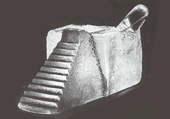
House,
sand - casted sculpture, 1981-1983. Photo: Ola Terje.
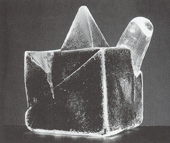
House,
1981-1983. Photo: Ola Terje.
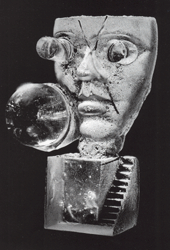
Portrait
of Jerzy Kosinski, 1983. Photo: Ola Terje.
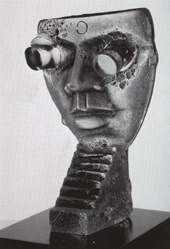
Portrait
of swedish author Sven Delblanc, 1983. Photo: Anders Qvarnström.
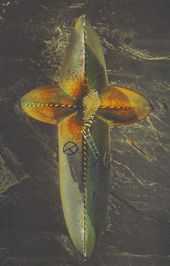
Crossboat,
1985.
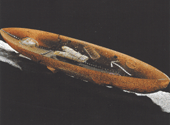
Destination
X, 1985. Belongs toVictoria and Albert Museum, London. Photo:
Anders Qvarnström.
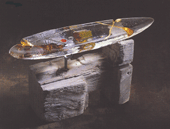
The
secret of the Barn.
Photo:
Anders Qvarnström.
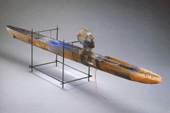
Voyage
of Dreams, 1986.
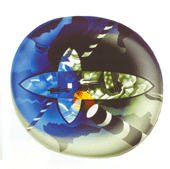
Crossboat,
sand - blasted platte, 1984. Photo: Lars G Ohlsson.
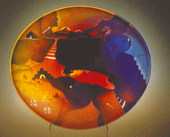
The
Ladder, sand - blasted platter, 1987. Photo: Ola Terje.
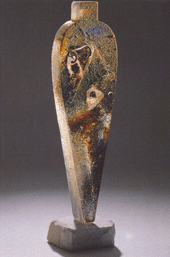
Cavo,
sand - casted, 1988. Photo: Anders Qvarnström.
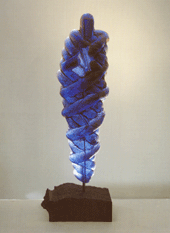
Nero,1988.
Photo: Anders Qvarnström.
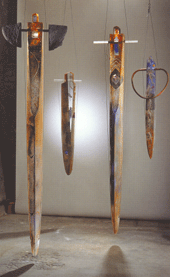
Pendulums, 1989. Photo: Anders Qvarmström.
|


